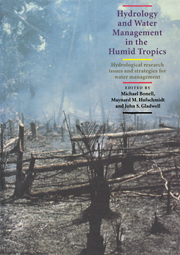 Hydrology and Water Management in the Humid Tropics
Hydrology and Water Management in the Humid Tropics Book contents
- Frontmatter
- Contents
- List of Authors
- Foreword by Federico Mayor, Director-General, UNESCO
- Preface
- Cartographic Credit
- Acknowledgements
- SECTION I INTRODUCTION
- SECTION II HUMID TROPICS SETTING
- SECTION III REGIONAL HYDROLOGY
- SECTION IV PHYSICAL PROCESSES
- SECTION V PHYSICAL PROCESSES – HUMAN USES: THE INTERFACE
- SECTION VI MANAGEMENT ISSUES
- SECTION VII APPENDICES
- Place index
Preface
Published online by Cambridge University Press: 23 December 2009
- Frontmatter
- Contents
- List of Authors
- Foreword by Federico Mayor, Director-General, UNESCO
- Preface
- Cartographic Credit
- Acknowledgements
- SECTION I INTRODUCTION
- SECTION II HUMID TROPICS SETTING
- SECTION III REGIONAL HYDROLOGY
- SECTION IV PHYSICAL PROCESSES
- SECTION V PHYSICAL PROCESSES – HUMAN USES: THE INTERFACE
- SECTION VI MANAGEMENT ISSUES
- SECTION VII APPENDICES
- Place index
Summary
The humid tropics are a treasure-house of natural resources. Beside making up twenty-two per cent of the globe's land area or 29.4 million km2, these warm and humid areas hold most of the world's uncut forest, most of the unharnessed hydroelectric power and most of the world's genetic riches among their estimated 30 milllion species of plants and animals. They may also contain vast, untapped supplies of minerals.
A significant proportion of the world's developing countries lie within the humid tropics and adjacent areas, and estimates suggest that by the year 2000 some 33% of the global population or more than two billion people will inhabit the humid regions.
The environmental and social problems found in the humid tropics are particularly complementary – and nearly all are related to water in some way. They are a result of population and land-use pressures and the failure to consider water resource management adequately within the context of general development plans for the region.
Until recently, little coordinated attention was paid to studying the hydrology of the humid tropics. With plentiful rainfall, apparently endless forests, and major rivers – like the Mekong, the Irrawaddy, the Ganges–Brahmaputra of East and South Asia, the Congo and Niger of Africa, and the Amazon and its South American tributaries – dominating the landscapes, it did not seem that water could be a problem.
UNESCO's International Hydrological Programme (IHP) has for several years realized the importance of the humid tropics and has organized projects to study various aspects of its hydrology and managing its water.
- Type
- Chapter
- Information
- Hydrology and Water Management in the Humid TropicsHydrological Research Issues and Strategies for Water Management, pp. xvii - xviiiPublisher: Cambridge University PressPrint publication year: 1993


